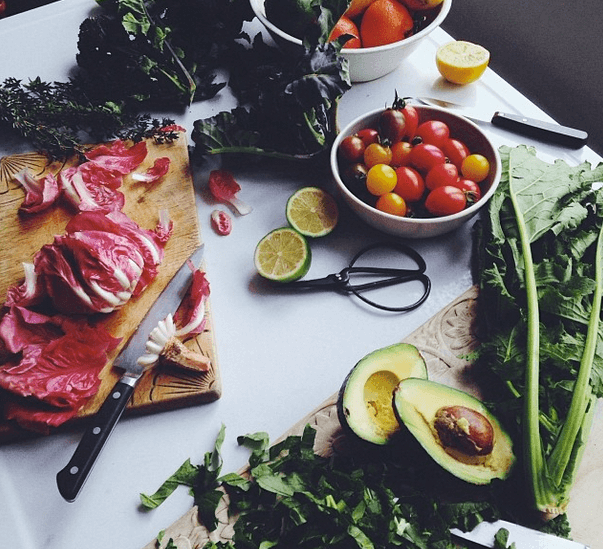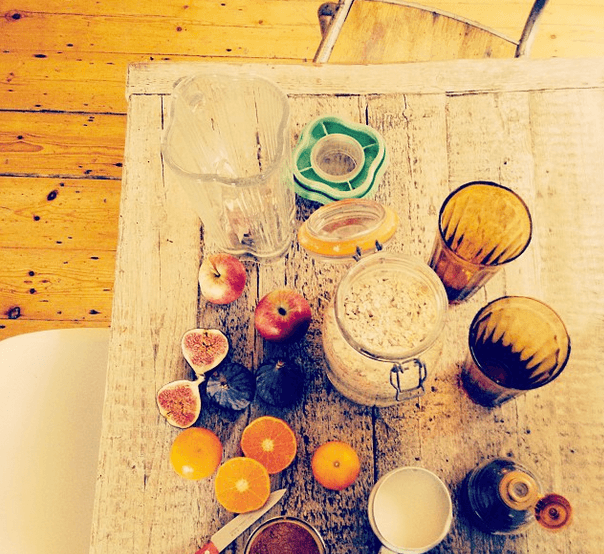About Time You Met: the Incredible Anna JonesBy Angelica Malin
Anna Jones is chef, food stylist and author of ‘A Modern Way to Eat’. She lives in Hackney and spends most of her dreaming up recipes, food styling and eating – read more about Anna here.
Through the lens, your days look crazy and exciting. What’s a normal day for you?

Though it sounds trite, there isn’t really a normal day for me. I’m not a lover of routine so my days are ever-changing. I flit between writing recipes, styling food and props for shoots. If I am on a shoot I could be in a studio in London or as far afield as the Caribbean. The only constant is that I will either be cooking food, writing about food or searching out amazing plates and backgrounds to put food on – so what I am eating is central to my day!
What do you eat on a daily basis?
I try to eat a nourishing breakfast, as it sets my intention for how I am going to treat my body for the rest of the day. If I am shooting I often take a jar of chia overnight oats, which I mix together in 2 minutes the night before. If I am writing at home in Hackney I usually make a juice or a energy packed smoothie when I get up. At the moment I am really into making a sesame, tahini and apricot smoothie.
I mix up fruits and leafy greens depending on what’s in season; I document them all on my Twitter and Instagram. When I am writing I get really, really hungry as I am always looking through old cookery books for inspiration – at about 11am I’ll have a piece of rye or seeded sourdough toast with almond butter and a roasted rice green tea.
What does ‘Modern Eating’ mean?
How we want to eat is changing. More of us want to cook without meat a couple of nights a week, and to make food that is a little lighter, healthier and easier on our pockets. But we don’t want to be chopping mountains of veg or slaving over the stove for hours to make satisfying meals. We need new ideas of ways we can all eat delicious food that nourishes our body.
Modern eating to me is working out how we can link up everything that has become important to us – provenance, nourishment, and seasonality and get it on everyone’s tables in a life-friendly time every night of the week.
It’s about the linking all this up – taking away any pious rules and rhetoric and eating well in a joyful way that celebrates the sheer delight of a really delicious plate of food.
What are we doing wrong as a nation? What should we be doing more of?
I think we are in a better place than we were 10 years ago; the awareness and education around what our bodies need is on the whole much better, most of us know what to do but few of us are doing it (and I include myself in that on occasion, as when I’m tired I can reach for a chocolate bar as quickly as the next person).

But I don’t think we are moving quickly enough. Obesity is one of the biggest killers in the UK. If it were guns or bombs or anything else killing so many people it would be front page news every single day. We all have a responsibility to vote with our wallets to buy fresh produce, fruit, veg, grains and raw ingredients and not processed high sugar, high fat fast foods that feed the obesity epidemic and doing the best we can to encourage everyone around us to do the same.
How did going veggie affect your cooking?
Because food is what drives me and gets me up in the morning, becoming vegetarian made me look at cooking in a new and more creative way. The building blocks that I had grown up with and rules I had learnt as a chef didn’t quite fit anymore. So the challenge to stay lower down the food chain and find new ways to add texture, interest and flavour to my food have meant using a new palate of ingredients and some new techniques in the kitchen. I use nuts a lot more in my cooking, I use them for pastries cakes and pestos. I use more nourishing fats like avocado, coconut milk and coconut oil.
I layer dishes with punches of texture and flavour no longer relying on the flavour to come from a piece of meat. I became much more conscious of what I was eating as I was having to think a little bit more about each meal I made, I think just making one change per day in your daily eating routine can open you up to being more focused and intuitive with what you out into your body. My cooking became quicker, tastier and more colorful and my waistine and food spend went down.
What’s your favourite go-to quick dinner dish?
If I am home late after a shoot I will have been cooking all day and although I am a cook I am under the same pressures of time and malaise as most people on a weeknight. My go-to quick dinner is usually a bowl of sesame and maple dressed soba noodles.
I make a quick 1 minute red cabbage pickle and sauté some tempeh or tofu in a little maple and soy until caramelised and then top with seasonal greens and sesame seeds. All ready in 10 minutes and deeply satisfying. I’ll finish off with a snap of dark chocolate. The full recipe is in “A Modern Way to Eat’
What tip would you give a budding chef trying to wow their friends at a dinner party?
This is advice to myself, really, as I always over-commit myself and cook for at least double the amount of people. My advice is: keep it simple. Don’t try to do too much. Give yourself one big, time-consuming thing to put your energy into and be smart with the other courses. If you put lots of time into a lavish man course buy some amazing antipasti to start and then finish with a quick homemade sundae or some fruit sorbet topped with Prosecco. Less is more.
People also love to be involved in their meal, the days of being served at a white clothed table are gone. There is a time and a place for that, for sure, but at home keep it informal, plate everything in big bowls for passing around, light candles, put someone in charge of music, make it a collaboration.
What foodie trend is on its way out?
Meat. I think we are all moving towards a more vegetable focused diet, eating meat everyday is becoming outdated and restaurants have cottoned onto the fact that people want more veg centered meals. I think these meat heavy, restaurants that leave you feeling like you need a week juice cleanse on walking out the door have had their day.
What will we all be eating next year?
Amaranth and Bee Pollen.
Amaranth is a bit like quinoa – a cereal-like herb that often gets mistaken for a grain that was eaten by the Aztecs. Amaranth packs a serious nutritional punch, as it’s really high in protein and calcium, so it’s great for people moving towards eating more veg. Amaranth also contains more calcium than milk, and it contains other minerals which allow the calcium to be absorbed much more easily. Amaranth can be found in all health food shops and some supermarkets. It can be a bit pricey but when you compare it to other foods that you would have to buy to get similar nutritional benefits, it’s a bargain. Use amaranth in place of couscous or quinoa in salads, or throw a handful into a soup. And it works well in place of rice alongside a curry too.
Bee pollen is not the stuff that floats around in summer and causes sneezing. Bee pollen is the pollen bees collect from flowers and take back to store in their hives. They go from flower to flower collecting the stuff and package it into little golden granules. Amazing. It may seem a bit out there to be eating this stuff but its an incredible whole food in the truest sense as it provides our body with almost every nutrient, vitamin and mineral we need, as well as being super high in protein and digestion boosting enzymes. Buy raw bee pollen in granules (not blocks) from your local health food sthop. If you can buy local bee pollen as it can help protect against allergies and tune you in to your local environment. Bee pollen is powerful stuff so start off with a teaspoon a day for adults, working your way up to a tablespoon and just a few grains, working your way up to ½ a teaspoon for kid.
Anna’s Book ‘A Modern Way to Eat’ is out now. Read more about Anna Jones here and follow her on Twitter here.











































